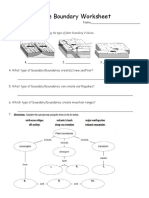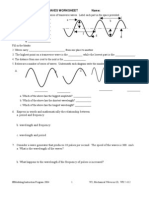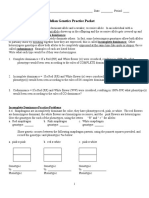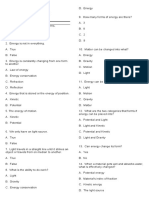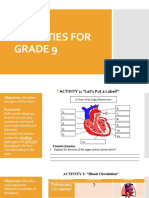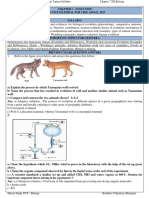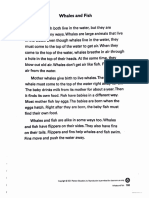Professional Documents
Culture Documents
Homology vs. Analogy Worksheet
Homology vs. Analogy Worksheet
Uploaded by
JAY CEE DELA ROSAOriginal Description:
Original Title
Copyright
Available Formats
Share this document
Did you find this document useful?
Is this content inappropriate?
Report this DocumentCopyright:
Available Formats
Homology vs. Analogy Worksheet
Homology vs. Analogy Worksheet
Uploaded by
JAY CEE DELA ROSACopyright:
Available Formats
Homology vs.
Analogy Worksheet
1.The wings of a bat and the wings of a butterfly are similar in that they both allow the
organisms to fly. Are bats and butterflies closely related? ___________________
Are the wings on these two organisms Homologous or Analogous Structures?
_______________
2. A duck and a platypus are similar in that they both lay eggs. Are ducks and
platypuses closely related? _______________
Is egg laying in these two organisms an example of a Homologous or Analogous
trait? _____________
3. Humans, Chimpanzees, and Gorillas all have similar hand structures. Are
humans, chimps, and gorillas closely related? _______________
Are the hands in these organisms examples of Homologous or Analogous
structures? ___________
4. Pigs and deer have similar ankle bones. Are pigs and deer closely related?
_______________
Are the ankle bones of these organisms examples of Homologous or Analogous structures?
___________
5. A shark and a penguin are similar in that they both have flippers to propel them
through the water. Are sharks and penguins closely related? _______________
Are flippers in these two organisms an example of Homologous or Analogous structures?
___________
6. Dogs and cats have similar paws. Are dogs and cats closely related?
_________________
Are the paws of these two organisms an example of Homologous or Analogous
structures? _________________
7. Monarch and Blue Morpho Butterflies have similar wings. Are monarchs and
morphos closely related? _________________
Are the wings of these two organisms an example of Homologous or Analogous
structures? _________________
Homology vs. Analogy Worksheet
1. Which species on the chart (A,B,C,D,E,F) is the common ancestor? ___________
2. Did the round nose of Species E and Species F come from the common ancestor? __________
3. Is the round nose of Species E and Species F a homologous structure? ____________
4. Did the square nose of Species D and Species G come from the common ancestor? ____________
5. Is the square nose of Species D and Species G a homologous structure?_____________
6. Are the cat ears of Species D and Species F homologous structures?_______________
7. Are the smiles of Species E and Species G homologous structures? _______________
Homology vs. Analogy Worksheet - KEY
1.The wings of a bat and the wings of a butterfly are similar in that they both allow the
organisms to fly. Are bats and butterflies closely related? No – Bats are mammals,
butterflies are insects
Are the wings on these two organisms Homologous or Analogous Structures? Analogous
since the animals are not closely related, so the wings likely developed independent from
each other rather than from a common ancestor.
2. A duck and a platypus are similar in that they both lay eggs. Are ducks and
platypuses closely related? No, one is a bird and one is a mammal
Is egg laying in these two organisms an example of a Homologous or Analogous
trait? Analogous structures since the animals are not closely related, so the egg
laying capability likely developed independently rather than from a common
ancestor.
3. Humans, Chimpanzees, and Gorillas all have similar hand structures. Are
humans, chimps, and gorillas closely related? Yes, both are mammals
Are the hands in these organisms examples of Homologous or Analogous
structures? Homologous since the organisms are closely related so the hands
likely came from a common ancestor.
4. Pigs and deer have similar ankle bones. Are pigs and deer closely related? Yes, both are
mammals
Are the ankle bones of these organisms examples of Homologous or Analogous structures?
Homologous since the organisms are closely related so the shape of the ankle bones likely
came from a common ancestor.
5. A shark and a penguin are similar in that they both have flippers to propel them through
the water. Are sharks and penguins closely related? No, one is a bird and one is a fish
Are flippers in these two organisms an example of Homologous or Analogous structures?
Analogous structures since the animals are not closely related, so the flippers likely
developed independently rather than from a common ancestor.
6. Dogs and cats have similar paws. Are dogs and cats closely related? Yes, both are
mammals.
Are the paws of these two organisms an example of Homologous or Analogous
structures? Homologous since the organisms are closely related so the shape of the paws
likely came from a common ancestor.
7. Monarch and Blue Morpho Butterflies have similar wings. Are monarchs and
morphos closely related? Yes, both are insects.
Are the wings of these two organisms an example of Homologous or Analogous
structures? Homologous since the organisms are closely related
Homology vs. Analogy Worksheet
1. Which species on the chart (A,B,C,D,E,F) is the common ancestor? A
2. Did the round nose of Species E and Species F come from the common ancestor? Yes
3. Is the round nose of Species E and Species F a homologous structure? Yes
4. Did the square nose of Species D and Species G come from the common ancestor? No
5. Is the square nose of Species D and Species G a homologous structure? No
6. Are the cat ears of Species D and Species F homologous structures? No
7. Are the smiles of Species E and Species G homologous structures? Yes
You might also like
- Basic Genetics Practice Problems Key 2Document4 pagesBasic Genetics Practice Problems Key 2Kendria Byrd100% (1)
- Biology Evolution Worksheet ANSWERSDocument3 pagesBiology Evolution Worksheet ANSWERSPsudopod0% (1)
- Homology vs. Analogy WorksheetDocument4 pagesHomology vs. Analogy WorksheetJAY CEE DELA ROSANo ratings yet
- Wave Calculations WorksheetDocument2 pagesWave Calculations WorksheetMIS NURUL IMAN Jakbar100% (1)
- Plate Boundary WorksheetDocument2 pagesPlate Boundary Worksheetapi-434008934100% (4)
- Balanced and Unbalanced ForcesDocument2 pagesBalanced and Unbalanced ForcesElias Blair50% (2)
- Incomplete-and-Codominance-Worksheet AnswersDocument2 pagesIncomplete-and-Codominance-Worksheet Answersreielleceana0779% (19)
- Waves WorksheetDocument2 pagesWaves Worksheettownsenr94100% (14)
- Plate Boundaries WorksheetDocument2 pagesPlate Boundaries WorksheetTawagin Mo Akong MertsNo ratings yet
- Non-Mendelian Genetics PracticeDocument13 pagesNon-Mendelian Genetics PracticeMariquit M. Lopez67% (3)
- Waves and em Spectrum Ws PDFDocument2 pagesWaves and em Spectrum Ws PDFJv Loo Caguioa100% (1)
- Ch. 3.1 Continental Drift Activity PacketDocument4 pagesCh. 3.1 Continental Drift Activity PacketShemae Obni100% (3)
- A Motivation Lesson Plan Mendelian Genetics v1Document4 pagesA Motivation Lesson Plan Mendelian Genetics v1api-14397507960% (5)
- TEST QUESTIONS IN SCIENCE 9 MELC-BASED (Analysis, Application and Evaluation)Document26 pagesTEST QUESTIONS IN SCIENCE 9 MELC-BASED (Analysis, Application and Evaluation)mayette100% (1)
- Study Guide Questions KeyDocument4 pagesStudy Guide Questions Keyapi-299996815No ratings yet
- Self-Learning Home Task (SLHT) Grade - 10 - Level 10 Quarter: 3 Week: 7Document9 pagesSelf-Learning Home Task (SLHT) Grade - 10 - Level 10 Quarter: 3 Week: 7GraceEstoleCalo100% (3)
- Summative Test For Grade 8Document14 pagesSummative Test For Grade 8marife gupaal100% (1)
- Macromolecules PRACTICE Test 2012 2013Document8 pagesMacromolecules PRACTICE Test 2012 2013edeceNo ratings yet
- Sean Burke - Marine Mammals WebquestDocument2 pagesSean Burke - Marine Mammals Webquestapi-386190429No ratings yet
- Natural Selection Quiz Review Guide Answer KeyDocument1 pageNatural Selection Quiz Review Guide Answer KeyHelen SagaNo ratings yet
- 13 - Bio - Determining Age of FossilsDocument8 pages13 - Bio - Determining Age of FossilsY Sa So RiNo ratings yet
- Science 8 1st Quarter Lesson 1 - ForcesDocument3 pagesScience 8 1st Quarter Lesson 1 - ForcesMara Ramos100% (1)
- DLP Science 9Document2 pagesDLP Science 9JJ TolentinoNo ratings yet
- Finals - Biology 2Document12 pagesFinals - Biology 2Leonel Mendoza100% (1)
- Grade 9 Science Summative Test Week 3Document3 pagesGrade 9 Science Summative Test Week 3Paul Ryan VillanuevaNo ratings yet
- Binomial ClassificationDocument14 pagesBinomial ClassificationadiNo ratings yet
- Grade 9 Diagnostic TestDocument6 pagesGrade 9 Diagnostic TestPedro GenosasNo ratings yet
- Lesson-Guide 2module - G9-Biology Module 2 On Template PDFDocument31 pagesLesson-Guide 2module - G9-Biology Module 2 On Template PDFconstancia G, caraan100% (1)
- Activity Worksheet.9 ScienceDocument5 pagesActivity Worksheet.9 Sciencelavenia acdal100% (1)
- WORKSHEET 14.3 Sex Determination in OffspringDocument3 pagesWORKSHEET 14.3 Sex Determination in OffspringafzalNo ratings yet
- CarbonylDocument4 pagesCarbonylJulie B. BongcalesNo ratings yet
- Electronegativity WorksheetDocument2 pagesElectronegativity WorksheetDn Angel100% (1)
- Lesson Plan Sex InfluencedDocument5 pagesLesson Plan Sex InfluencedQueencess Ara Torres100% (1)
- Ecological Relationship: Oppositional RelationshipsDocument7 pagesEcological Relationship: Oppositional Relationshipsjeanette PradesNo ratings yet
- Non-Mendelian InheritanceDocument6 pagesNon-Mendelian InheritanceJONATHAN TABBUNNo ratings yet
- Grade 9 Science ActivitiesDocument11 pagesGrade 9 Science ActivitiesESMERALDA GAMILNo ratings yet
- 9 MassDocument4 pages9 MassxoxkakidoxoxNo ratings yet
- Science 10 - Q2 - W8 - D2Document2 pagesScience 10 - Q2 - W8 - D2zenaida a academia100% (1)
- Biodiversity and EvolutionDocument99 pagesBiodiversity and EvolutionMaria Jamilla R. Pua100% (1)
- Summative Test 9Document2 pagesSummative Test 9Ginalyn B. Entea50% (2)
- Force Balanced and UnblancedDocument2 pagesForce Balanced and UnblancedLuisa RamosNo ratings yet
- Light Lesson Concave N Convex LensesDocument3 pagesLight Lesson Concave N Convex LensesAnonymous wksd8qcaZ100% (1)
- 7th Grade Cell Theory LessonDocument5 pages7th Grade Cell Theory Lessonapi-375487016No ratings yet
- Quiz Levels of Biological OrganizationDocument2 pagesQuiz Levels of Biological OrganizationCheMaeNicolGile100% (1)
- A Detailed Lesson Plan in Science 10Document9 pagesA Detailed Lesson Plan in Science 10Maricae NathanielNo ratings yet
- Science 9 ODL L3 Week 4-5 PRINTEDDocument4 pagesScience 9 ODL L3 Week 4-5 PRINTEDClarice Jenn MaltoNo ratings yet
- Learning Activity4.1 (Science Grade 8) : Name: Grade/Score: Year and Section: DateDocument2 pagesLearning Activity4.1 (Science Grade 8) : Name: Grade/Score: Year and Section: DateMa Lou100% (1)
- Demonstration Lesson Plan in Animal and Plant CellsDocument5 pagesDemonstration Lesson Plan in Animal and Plant CellsCristina Aguinaldo0% (1)
- Evidence of Evolution AnswersDocument8 pagesEvidence of Evolution AnswersAnoNo ratings yet
- Incomplete and CodominanceDocument4 pagesIncomplete and CodominanceTrisha Melrose Milanes100% (1)
- Biotechnology Guide Grade 8Document30 pagesBiotechnology Guide Grade 8Mary Celky Espinosa100% (1)
- Wk-6-Activity-Sheet g9Document6 pagesWk-6-Activity-Sheet g9Christine Marquez RamosNo ratings yet
- Activities For Grade 9Document6 pagesActivities For Grade 9Richelle100% (1)
- Worksheets: No. 1-7 Topics: Plate Tectonics Plate BoundariesDocument11 pagesWorksheets: No. 1-7 Topics: Plate Tectonics Plate BoundariesJohnKennethPrescillaSilloriquezNo ratings yet
- g10 Periodical TestDocument4 pagesg10 Periodical TestSHIELLA MALANOGNo ratings yet
- PAMINTUAN, JOHN ERIC L. - WEEKLY-HOME-LEARNING-PLAN-IN - SCIENCE 8 - Q1 M1 ForceDocument2 pagesPAMINTUAN, JOHN ERIC L. - WEEKLY-HOME-LEARNING-PLAN-IN - SCIENCE 8 - Q1 M1 ForceL.J. SantosNo ratings yet
- Correlating Rock Layers Using Index Fossils Worksheet November 2Document2 pagesCorrelating Rock Layers Using Index Fossils Worksheet November 2Joy Perez50% (6)
- Science Activity SheetsDocument4 pagesScience Activity SheetsRose Ann Chavez100% (1)
- Ionic Formulas Lesson PlanDocument9 pagesIonic Formulas Lesson Planapi-357585508No ratings yet
- Homolgy and Analogy (Understanding Evolution)Document3 pagesHomolgy and Analogy (Understanding Evolution)ellaNo ratings yet
- Evidences of Evolution Structure and EmbryologyDocument42 pagesEvidences of Evolution Structure and Embryologycnsths.cerbo.maryvalerieNo ratings yet
- What Are Analogous StructuresDocument6 pagesWhat Are Analogous StructuresjunaidNo ratings yet
- ds103 Evolution Vocabulary BingoDocument6 pagesds103 Evolution Vocabulary Bingoapi-110789702No ratings yet
- Biology Chapter 2 ReviewDocument9 pagesBiology Chapter 2 ReviewheshNo ratings yet
- Chapter - BIOLOGY XII PYQDocument17 pagesChapter - BIOLOGY XII PYQjagec31687No ratings yet
- Marine Biology 9Th Edition Castro Test Bank Full Chapter PDFDocument32 pagesMarine Biology 9Th Edition Castro Test Bank Full Chapter PDFpottpotlacew8mf1t100% (15)
- Turtle Mimetic Soft Robot With Two Swimming GaitsDocument17 pagesTurtle Mimetic Soft Robot With Two Swimming GaitsIEEE PROJECTS MICANS INFOTECHNo ratings yet
- Department of Education: WednesdayDocument10 pagesDepartment of Education: WednesdayQueenvierlyn RupidoNo ratings yet
- Fossils: Evidence For Evolution Worksheet: PaleontologyDocument3 pagesFossils: Evidence For Evolution Worksheet: PaleontologyJermaine Barnett-Weeks100% (1)
- The Tubercles On Humpback WhalesDocument1 pageThe Tubercles On Humpback WhalesJane Erestain BuenaobraNo ratings yet
- GMF L3 Units 1-9 Standard Level TestsDocument36 pagesGMF L3 Units 1-9 Standard Level Testsprzybylo.annamonikaNo ratings yet
- 2nd ExpositoryDocument4 pages2nd Expositoryapi-595567391No ratings yet
- YEAR 3 PKSR 2 2018 English Paper 1: NAME: - ClassDocument10 pagesYEAR 3 PKSR 2 2018 English Paper 1: NAME: - Classg-30514046No ratings yet
- Evolution Previous MCQsDocument16 pagesEvolution Previous MCQsNirmal ChakravarthyNo ratings yet
- Fish Fin: Types Bony FishesDocument23 pagesFish Fin: Types Bony FishesNirmal BhowmickNo ratings yet
- Amanda Watson 02 17 2021 - When Whales Walked Worksheet Parts 1-4Document8 pagesAmanda Watson 02 17 2021 - When Whales Walked Worksheet Parts 1-4api-439458292No ratings yet
- Y3 PKSR2 P1 (Bymissash)Document10 pagesY3 PKSR2 P1 (Bymissash)SYKE CRAFTNo ratings yet
- Leading-Edge Tubercles Delay Stall On Humpback Whale (Megaptera Novaeangliae) FlippersDocument5 pagesLeading-Edge Tubercles Delay Stall On Humpback Whale (Megaptera Novaeangliae) Flipperselsonchua51No ratings yet
- Multiple-Choice READING: PenguinsDocument2 pagesMultiple-Choice READING: PenguinsYaricel MorrisNo ratings yet
- NHF L3 Units 1-9 Standard Level TestsDocument36 pagesNHF L3 Units 1-9 Standard Level TestsNadiaNo ratings yet
- Grade 4 Animals That Live in Water HabitatDocument36 pagesGrade 4 Animals That Live in Water HabitatMARY EUNICE CAGADASNo ratings yet
- Gen Bio 2 PhylogenyDocument36 pagesGen Bio 2 PhylogenyConrado Juisan CrisostomoNo ratings yet
- National Geographic Kids 2020 08Document36 pagesNational Geographic Kids 2020 08jiyoon Kim100% (1)
- Kami Export - Rogdrena (2023) Troupe - Role-Of-Homologous-StructuresDocument5 pagesKami Export - Rogdrena (2023) Troupe - Role-Of-Homologous-StructuresStacy TroupeNo ratings yet
- A Whale Humerus Ironically Shaped by Neutral EvoluDocument32 pagesA Whale Humerus Ironically Shaped by Neutral EvoluGunther EbleNo ratings yet
- Let S Look AnimalsDocument35 pagesLet S Look AnimalsmamtaNo ratings yet
- CBSE Class 10 Science Lab Manual - Homology and Analogy of Plants and AnimalsDocument7 pagesCBSE Class 10 Science Lab Manual - Homology and Analogy of Plants and AnimalsAryan SinghNo ratings yet




